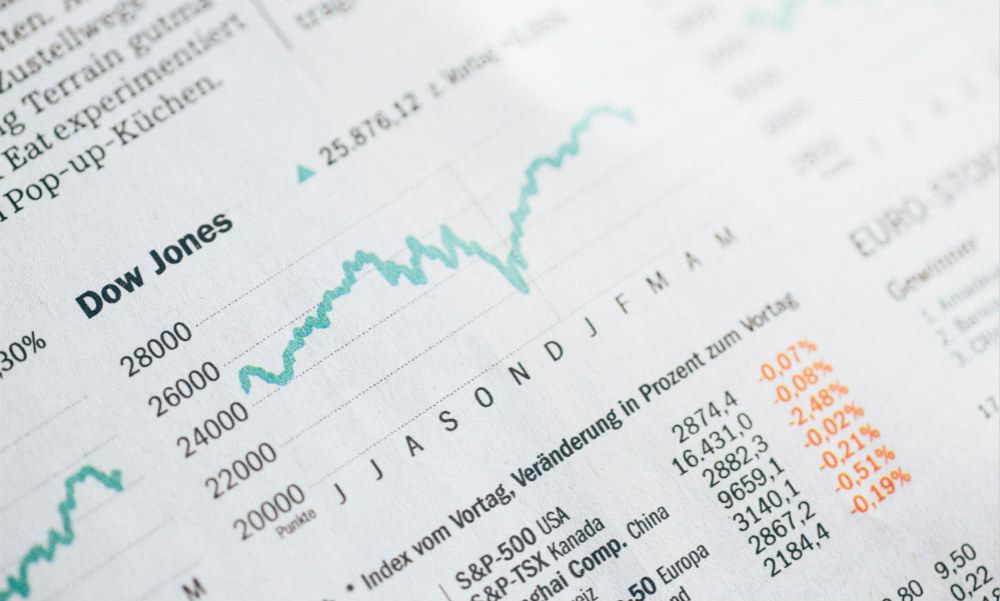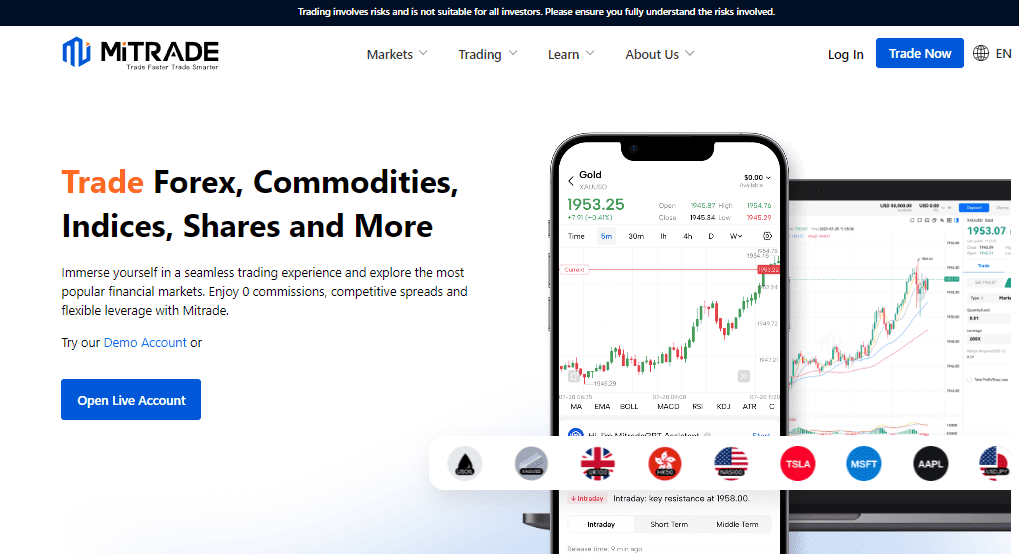How To Trade Indices? Index Trading Beginner's Guide for 2023

While there are different types of asset classes to trade at Mitrade, including Forex, Commodities, and Cryptocurrencies, Stock Indexes are one of the most popular and for good reason.
You can trade Stock indices like the Nasdaq, DAX, SPX500, AUS200, and the US30 with Mitrade leveraged CFD trading account.
This article will introduce you to the exciting world of index trading and explain how to trade stock indexes like a pro. Don't worry, you'll learn the basics of indices and some of the best strategies employed by successful CFD index traders.
What Is Index Trading? How Does It Work?
Index trading is a way of betting on the overall performance of a group of stocks, instead of buying individual shares.
Stock indexes have been around since the original Dow Jones Index was first created in 1885. Charles Dow, working at the Wall Street Journal, wanted a way to quickly aggregate the performance of the economy at that time. He picked 30 big companies and averaged their prices to get an index, the result was the Dow Jones Industrial Average.
But you couldn't trade the index back then. You had to buy all 30 stocks in the same proportion. Not very practical at all.
That changed in the 1970s when they invented financial products that are called stock index futures, which are mostly for big banks and rich people.
But now, anyone can trade indexes with other tools, like ETFs, Options, and Stock Index CFDs. These are contracts that let you profit from the price movements of an index, without owning the actual stocks.
Stock index CFDs are one of the primary products here at Mitrade.

CFDs is one of the most popular ways to trade indices. They are traded on margin, meaning that for a small refundable deposit you can actually control a much larger trading position. You can also profit from both rising (going long) and falling (going short) markets.
Index CFDs is a simple but effective way for a trader to speculate from the direction of the stock indexes. Traders from all over the world day in and day out place trades on these markets. Some take quick intraday trading opportunities, others prefer short-term swing trading, while others prefer long-time frames lasting weeks or months.
With the leverage, it opens up many opportunities for those who wish to partake in this very exciting and potentially lucrative business.
For anybody wanting to learn the ropes of trading, the Stock Index is a great entry-level product, something I will discuss more in-depth later on.
Find The Best Indices To Trade For Beginners
Index trading takes place on many different indexes throughout the world, but the most popular with retail traders are the major world indices: Nasdaq 100, SP500, US30, Aus200, and DAX. You can trade these indices at Mitrade trading platform
★ SPX 500
One of the biggest indices is the SP500. It includes the top 500 US companies by market value. You might know some of them, like Facebook, Google, and Microsoft. But they are not the only ones that matter.
The SP500 is a good way to measure how the US economy and the global economy are doing.
★ Nasdaq 100
If you're into tech stocks, you might have heard of the Nasdaq 100 Index. It's a list of the top 100 non-financial companies on the Nasdaq Stock Exchange, which is known for its focus on innovation and technology.
FAANG (Facebook, Apple, Amazon, Netflix, Google, or Alphabet) stocks, which are popular in the world, are included in the Nasdaq 100 Index. In fact, more than half of the index is made up of tech companies.
The Nasdaq 100 Index has been doing great lately. It has grown by almost 16% every year for the last 15 years.
But be careful, because tech stocks can be risky. The Nasdaq 100 Index can swing up and down a lot if the tech sector faces any trouble, as it has in the past.
★ US30
The Dow Jones Industrial Average, or the Dow, is the oldest and most famous stock market index in the world. It started in 1896 and has survived the market crash of 1929 and the Great Depression. The Dow is now close to 30,000 points.
The Dow tracks 30 big companies that change over time. The last original company to leave the Dow was General Electric.
The Dow includes some of the most popular stocks in the world, like Facebook, Alphabet (Google), Microsoft, and Amazon. These stocks have a lot of influence on the DJIA.
★ AUS200
AUS 200 is the leading stock index in Australia. It is very popular because it is a leading benchmark of not just Australia but Asia generally.
Many of its components are affected by what happens in China. If China is booming, then the AUS200 rides high. If China is faltering, then so is the AUS200.
The index has a large weighting of mining stocks. The world's largest miner BHP Billiton is listed there. As is another behemoth Rio Tinto. This means during commodity booms the index tends to outperform other world markets.
However, the index also other sectors like financials, consumer goods, real estate, and tech, which still make the index a decent proxy for the Australian economy in general.
★ DAX30
The DAX 30 index, known as GER30 or DE30, includes the top 30 most valuable companies on the German stock exchange. It symbolizes Germany's economy and contains some of Europe's most important industrial and technology firms.
The DAX index has increased in value from 1,000 to around 11,000 since its inception in 1988, which is a 1,000% gain.
★ UK100
The UK100, or FTSE100, is a popular index for CFD traders. It tracks the top 100 companies in the UK, like HSBC, BP, Shell, and Vodafone. These stocks can make the UK100 go up or down a lot.
The UK100 is also linked to oil prices because many of its companies are oil producers. Unlike the AUS200, which is more about mining.
Another thing that makes the UK100 interesting is its location. It's in the middle of Asia and the US, so it can catch different market trends at different times of the day.
How To Trade Indices On Mitrade?
Let's look at a trading example on AUS200.
Step 1: You're using a MACD crossover system on a 15-minute chart
Step 2: The indicator is about to flip from red to green which is a bullish sign
Step 3: You place a market order at the buy price of 7077
Step 4: You add a protective stop loss 10 points below the current price
Step 5: You wait patiently for the price of the index to rise
Step 6: Plan to take profits 30 points higher for a 3 times risk-reward ratio
If you're looking for a reliable broker, check out Mitrade. Mitrade is an award-winning broker regulated in Australia by the ASIC. Index Stocks are a major part of the service that they offer to clients, you can also get competitive spreads on other markets, such as forex, us stocks, gold, commodities, and cryptocurrencies.
- Register a demo account for free and level up your trading skills.
- At the same time, enjoy a sum of $50,000 virtual money to practice and formulate your best strategies before switching to a live account. Practice Now ››
Wanna Learn More? go to the share market with Mitrade.com>>
Direct market access | Deal on rising and falling market | 24-hour trading | Limit and stop-loss for every trade
Advantages Of Index Trading With CFDs
There are many advantages of trading stock index CFDs.
● high leverage
● less risk than individual stocks
● long and short trading
● tight spreads
● natural bias to the upside
● less intraday volatility than other asset classes
The last two are rarely discussed makes all the difference to your trading results.
Yes, you can indeed go short stock indices, and make money very fast if you can get your market timing correct.
The crash of 2008, the Taper Tantrum of 2010, and the Flash Crash of 2013 are all testament to that. But besides the often brief but sharp sell-offs, stock indexes do actually spend most of the time in uptrends.
Why is this?
Well, as in the case of the Dow as talked about previously, poor-performing companies are dropped over time from an index. And in turn, replaced by star performers. This gives the index a natural drift upwards.
Also, there is simply too much money out there among hedge funds, pension funds, investment funds, and mutual funds and all of them need to spend it somewhere!
This is good for you because, let me you, from all my experience trading CFDs, it's much easier to make money on the long side than the short side.
Stock markets just go up easy than they go down, and at the end of the day, the job of a trader is to take the line of least resistance – which is usually up.
Also, intraday volatility tends to be much less in stock indices than say in Forex or commodities.
Again, this can lead to irrational and emotional decisions if you are currently lack trading experience. Which all go to make Stock Index CFDs the best entry-level instrument for traders.
Conclusion
Index trading is the best way for beginners to get started in this business. Yes, other markets might be more exciting, moving faster and stronger, but that does not always want a beginner's needs.
The natural bias to the upside in indices cannot be overstated.
And because of intraday volatility when Stock Index trading is lower, those who haven't quite yet mastered the psychological aspects of trading can still find early success.
If you're serious about being a trader trading stock Index, try to trade with a demo account. Mitrade provides $ 50,000 practice funds allowing you to master your strategies before trading in real-world. You'll find the trading platform simple and intuitive with fast execution.
Wanna Learn More? go to the share market with Mitrade.com>>
Direct market access | Deal on rising and falling market | 24-hour trading | Limit and stop-loss for every trade
* The content presented above, whether from a third party or not, is considered as general advice only. This article should not be construed as containing investment advice, investment recommendations, an offer of or solicitation for any transactions in financial instruments.


